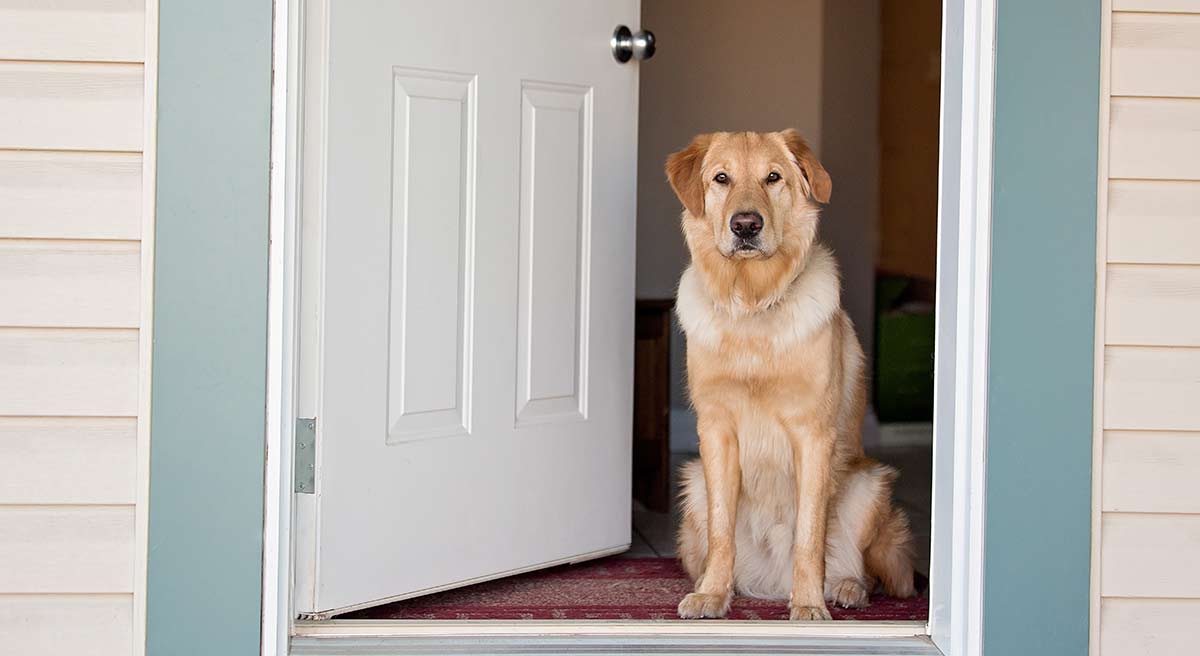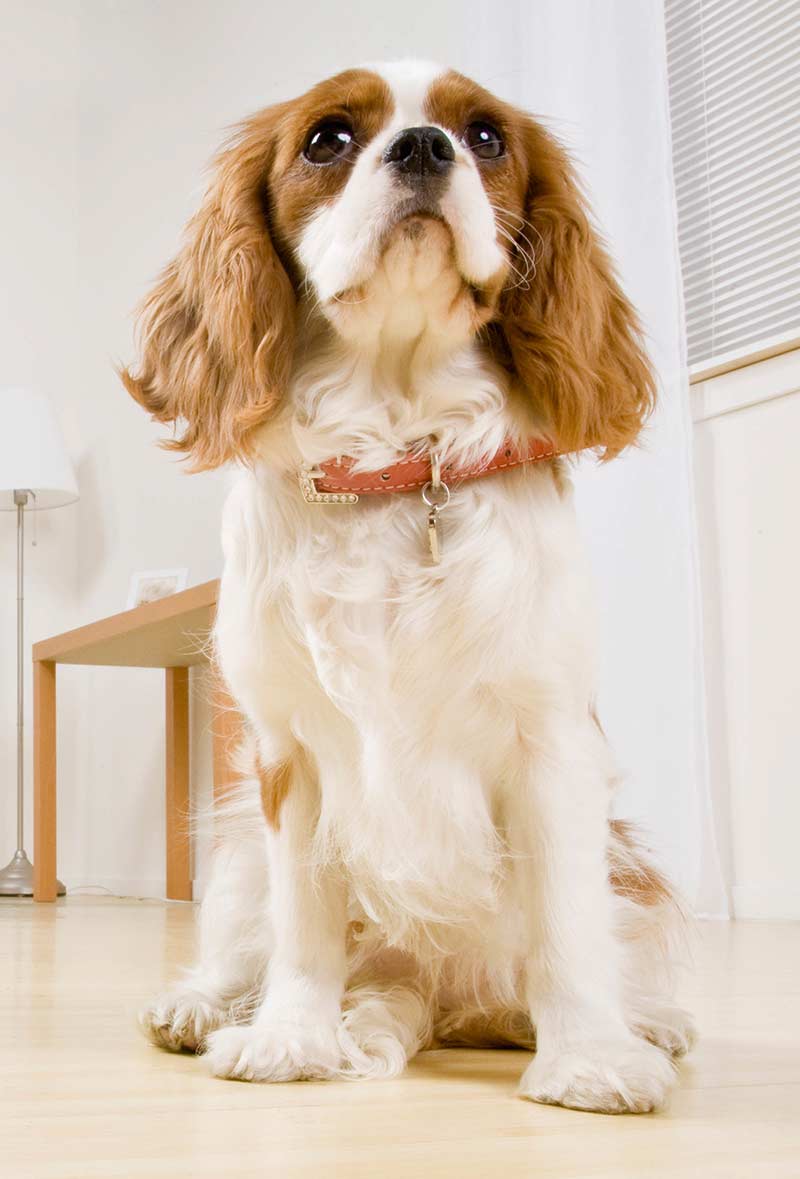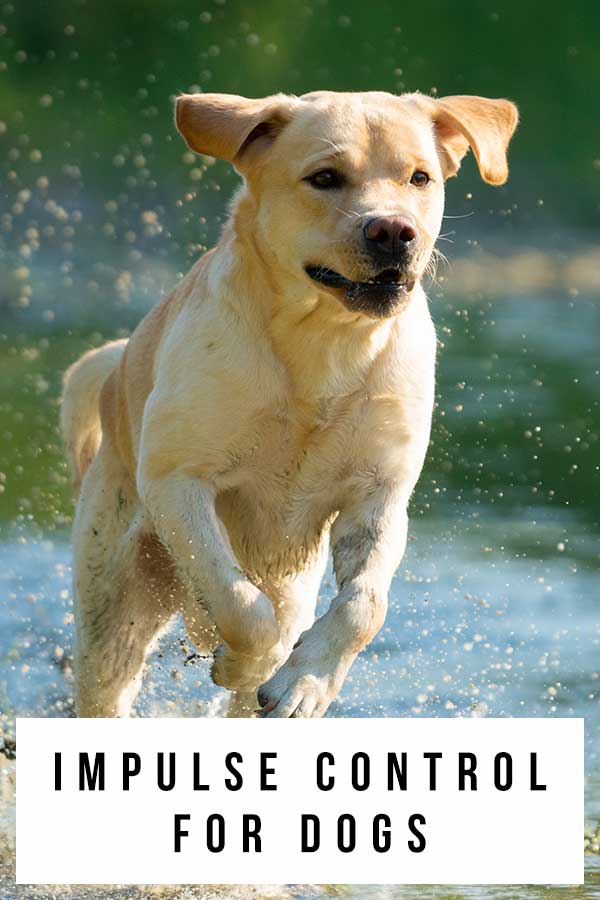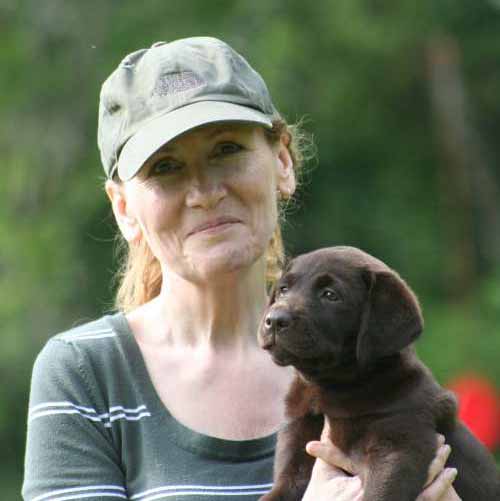
It’s common to see lack of impulse control in dogs and small children. We all know an adult or two that suffers from it from time to time, too!
It is lack of impulse control that makes dogs rush headfirst into danger.
Uncontrolled dogs bowl people over in their enthusiasm to say hello, barge through doorways, and snatch food from your fingers.
All this is perfectly natural, especially with friendly, and greedy dogs. But, for the most part it’s not a good thing.
Obedience training
One approach to dog training is to train a dog to respond to specific commands. So you can teach a dog to sit still in the car while you open the door by telling them to sit, or stay, or wait.
We can teach, “Leave it,” to tell a dog to back off and ‘not touch’ when you give the command.
And so on.
But this article is about a slightly different approach.
I’m going to talk about teaching dogs to control their impulses in specific situations, without the use of any commands or cues, at all. And we do this, by creating default behaviors.
Teaching Default Behaviors
These are learned behaviors that the dog offers in response to specific situations, rather than in response to a signal from a person. The situation IS the cue
For example, we can teach a dog that the only way to get through a door is to sit politely in front of it.
We can teach them that the only way to get someone to stroke them is to keep their feet firmly on the ground.
Your dog can learn that the only way anyone will clip on their leash is if they stands quite still.
And the only way you will put their dinner bowl on the floor is if they sit and look at you first.

Using His Brain
A nice thing about default behaviors is that the dog is making their own decision, rather than being told what to do.
When you train default behaviors, your dog is having to think, and use their brain. This is good mental exercise and helps them improve their learning skills.
Your dog is learning that choosing calm and polite behaviors is more likely to get them what they wants.
And the more situations in which your dog learned to control their natural impulses, the easier they will find it to learn new ones.
Impulse control is something that dogs become better at with practice.
I’ll give you some examples below, and you can also find examples of this kind of training in the tips that I send out by email. Drop your address in the box below if you’d like to receive them
Here is an example of how to teach a default behavior to your dog.
Bad Behavior Before A Walk
Many dogs behave very badly when they think they are going for a walk.
They see the lead come out or hear the jingle of your car keys, and go to pieces.
Some dogs bounce up and down, or race around the house knocking things over. Others bark repeatedly or spin in silly circles while their owner tries unsuccessfully to get them to sit still.
Does your dog appears to be hysterical with excitement each time you leave the house?
If you have to wrestle them to the ground in order to clip on a leash, while giving a stream of commands they are never going to obey, try this little exercise.
Sit To Be Leashed
This is for owners of dogs that spin and/or bounce when they see their leash.
Do this exercise when you have at least an hour of spare time and know that you will not be interrupted.
Your aim at this point is to hold the leash in one hand and grasp the dog’s collar with the other, without him moving. But don’t touch him yet.
- Get out your dog’s lead and stand quite still, holding it in your hand.
- Now wait.
You are waiting for a pause. He can’t keep up the spinning or bouncing forever. Don’t talk to him, don’t give him any commands. Just wait. As soon as he pauses:
- Reach your other hand out towards him.
Off he will go, spinning or bouncing again. All you have to do is:
- Withdraw your hand and wait him out again.
Each time he stops, reach out your hand. Withdraw it as soon as he starts the behavior you don’t like.
A Warning
Things may get worse before they get better.
Be patient. The first time you do this it will take a while. In fact, the spinning and bouncing may be worse than ever for a while.
This is because the dog believes that the spinning and bouncing gets him a walk.
This is a perfectly reasonable assumption on his part.
So when you behave strangely and refuse to put on his lead, he may spin and bounce harder to begin with.

Eureka!
Sooner than you think, your clever dog will have a “Eureka!” moment.
“This isn’t working,” he will say to himself.
And he will try something different. He might fetch you a shoe. Or his dinner bowl. Just ignore him and wait.
Each time he becomes calm, stretch out your hand. You will soon be able to touch his collar and hold on to him. When you can do this without him getting excited:
- Clip the lead on his collar and reward him.
Having the lead on is in itself rewarding. You can make it more so. The extra reward can be food or the walk he was hoping for. He just needs to know that standing still is what works.
When this happens, you have made a major breakthrough.
From now on, it all gets easier.
New Standards
Repeat this little training session as many times as you can over the next few days, and make a commitment to these new standards.
From now on, never clip a lead on to your dog until he is standing quietly. You can wait for him to sit if you want to, but standing still is fine.
Be patient and practice
It takes more than one session to make permanent changes to your dog’s behavior. So you’ll need to practice this – several times a day is ideal.
In the meantime, never let anyone else clip a lead on to your dog until he is standing quietly.
You want the dog to have no doubt that standing still is what gets him a walk.
And he needs to know that from now on, you will not attach a lead to his collar under any other circumstances.
Door barging
You can use the same exercise for a door-barging dog. Hold your hand on the door and wait for the dog to back away.
Don’t start to turn the handle until the dog has backed away from the door.
If the dog rushes forwards release your grip on the handle and wait. As soon as he backs away, grasp the handle again and slowly start to turn it.
In fact, you can apply these principles to many other behaviors you want to eradicate and replace with a different behavior.
There are no complications, no commands, no talking. Just wait the dog out.
Control
This kind of learning not only teaches your dog to control himself. It teaches him that he can control some of your actions too.
If he behaves politely, he can make you give him what he wants. If he doesn’t behave politely he gets nothing.
Modern dog training teaches dogs how to figure out the best way to please you. And you’ll find more exercises like these in our online dog training courses.
Teaching your dog good impulse control is brilliant preparation for a great training relationship between the two of you.
The Extinction Burst
Remember that the dog may escalate the bad behavior before it gets better. If something, that worked before, stops working most animals will try harder for a while before giving up.
The correct term for this is an ‘extinction burst’ – it’s what happens just before bad behaviors become extinct.
Pick Your Default
Choose one impulsive behavior that you don’t like in your dog, and plan how you can reward him for choosing a better alternative.
Remember, you are not going to teach him a command, but you’ll control access to what he wants, until you get the behavior from him, that you want.
You can do it! Give it a go, and let us know how you get on!
‘Impulse Control For Dogs’ was written by Pippa Mattinson, best selling author of Total Recall and The Happy Puppy Handbook, and the founder of the Dogsnet Training Program

Free Training Tips
Get Pippa's free dog training tips delivered to your inbox


Hi Pippa,
I would like advice on stopping my 5 mth old border collie from jumping on people with excitement. I like the idea of impulse control training. However I can’t let her jump on people (even if they are ignoring her). Maybe just have her on a leash where she jumps about madly until she works out that it isn’t getting her anywhere? (she cant listen to the sit command as she is too distracted with excitement).
What are your thoughts?
How do i stop my GS from barking and barking
How do I get my 98 lb lab from charging the door and people when they come in?
This is good stuff
I need advice on how to keep my two labs from charging through the door whenever someone comes over. They never do this when just the three of us. They always wait until I give them the ok.
What do I do about a counter surfer? He can even open cabinets, a little floor freezer & a microwave.
Needing advice on how to stop our 10 mos shepherd from going crazy when the doorbell rings or a knock on the door
Before I do this, is it free?
How do I get my 1 year old Essie to stop biting my feet and slacks while walking
How do you stop a puppy from bitting you ?
He’s 7 weeks old and bites until you are bleeding ! He even attacks when I get in the bed , HE IS RELENTLESS ! Until. He wares himself out !
Is he too young to train?
I have a 11 month GS and he has started biting on things my wall my barstool a blinds and now left in back yard and he chewed on a tree that we are growing well we was how to stop them from doing this
Hi Pippa, My 10 year old shepherd is very well trained…he will heel, stay, wait, place, etc. The only time he’s out if control is at bath time. He loves getting a bath and thinks it’s a game…He will attack the hose as he goes ballistic at the sight of water. He’s been this way all his life. Bath time is so exhausting for me to the point that I dread it. And going to a groomer is out of the question. Do you have any advice as to how to calm him down during a bath? He also goes after the vacuum cleaner and ripped a hole in the hose, so now I just kick him out onto the lanai until I’m done. But I can’t do that for his bath!
I’ve seen lick mats that attach to walls around tubs with suction cups. Smear peanut butter in them and whie they lick the pb out of yhe crevices, you can wash your dog. I got one I use on the floor to keep my golden busy so I can brush her.
We adopted a two year old terrier mix that we adore!! But when people visit he gets so excited that he urinates. We take him out ahead when we know people are coming over but he won’t always need to go. We started putting a diaper on him before they arrive. After he settles down over the original excitement he tends to “usually” not do it
I have 3 dogs. Two are manic when time to walk one at a time. Mild 3rd dog is becoming more excited by other 2-. It’s very stressful when time to walk. Any Suggestions. BTW, first 2-dogs received 50 hours of training. The 3rd dog is hyper manic.
Any advice on how to stop a 5 month old puppy from digging in the yard?
Any advice on my 10 month old GDM who wakes me up at 3 am on my side of the bed barking but doesn’t need to go potty wants me to get up and come sleep on the couch and then shes fine won’t stop barking till I get up and go down there but I get up for work at 6:30 shes been doing this for 3 weeks and I’m so over it
Any suggestions on how I can walk towards our Lakefront with my silver lab jumping & barking again me as he wants me to throw a stick. If I pick up a stick he jumps & barks..
Can you tell me how to get my Golden lab to quit barking when and before people come to the door. I understand her barking to let me know when someone is knocking on the door. The problem is she won’t stop barking when I open the door. Mollie wants to get at the door to be able to sniff them
And they need to pet her and acknowledge her first. Please help me learn how to make her stop her excessive barking.
I would love to be able to walk my 3 year old lab on a leash without her pulling and dragging me along. She’s stronger than I am!! Her nose wanting to sniff everything seems to override her sense and listening ability.
I got a smart collar like a prong collar. It works no pulling no dragging. The one I use is plastic ordered from Amazon. It is called star mark training collar. Walking is no longer a scary adventure.
My first dog did this- we used a front-lead harness which redirects their ‘pull’. And each time he pulled, I came to a complete stop. Meaning he had to stop and wait to go again.
I won’t lie- it was challenging and took ages. If she’s treat happy- bring treats and redirect her back to pay attention to you with them too 🙂
Good luck
My Dog, rushes to door barking her head off when someone knocks , Also when anyone pulls in driveway or myself drives in she runs to the car and won’t listen to stay. What you do?
Hi Pippa,
I have a 2 y old 90lbs rescue. We adopted him when he was 9 weeks old. He goes at an outdoor daycare twice a week and I walk him twice a day,daily. We also play with him, do some tricks training.
We live in a small community so walking your dog without meeting another dog is close to impossible.
Tuk reacts to other dogs immediately and he can spot other dog from far.
When comes to food his leave it is very good but when it comes to other dogs……
I use treats and double end leash but it is still very difficult.
Any advice ?
Thanks a lot !
I have the same issue. I adopted a dog a month ago that is about a year old. She is learning to walk on leash and does well till we see another dog, then she goes crazy. I finally found the high value treats that will distract her from the other dog but it doesn’t stick.
I am hoping to read some tips about dogs going overexcited at the sight of another dog.
When I see something (a trigger) I start talking calmly to them, like”look at her red shit, I like red, her hair is nice too, she must be going to work”……oddly enough this keeps them calm as we pass.
Our 11 month labrador likes to lick us when she is near us. Can you suggest anything to stop this. We have tried a lick mat with no effect.
My standard poodle has started to run to the door and leap on the door when someone comes to the door. He is 5 and started this about a year ago. The only thing that stops him is if I take up the runner in the hall. It seems to be a game with him. He doesn’t jump on people at any time. Other than the leaping he is very well behaved.
Hi Pippa,
Thanks for this 😊 It has successfully worked with Juno for getting her leash on going out the door.
Can you suggest how I successfully stop her from leash wrangling at the end of an exercise session to come back in to the house please? ( she’s on a long line as my garden is very big) She’s a 4 month GSD and very reactive.
Thank you!
Kate
Hi Pippa
Great advise thank you! Will definitely use this on my 4 month Working Cocker!
Can you offer any advise on how to teach him to settle down (after his long walk & play session) in the evening when we want to just sit & watch TV please? He’s constantly jumping up ar the sofa for attention & nipping clothes or hands.
Thanks Paula x
Any thoughts on remaining calm when there is someone at the door?
This training technique makes great sense. How do I apply it to a dog that excitably jumps on my guests – over and over. She does not jump on my husband or on me. It is the excitement of seeing someone else. She is big and can knock someone over. Thanks
I have a Houdini! 70 lbs and keeps finding ways to escape the yard.
I also need tips on this. We’ve tried ignoring her until she calms down but it has not been successful. I’m afraid she’s going to hurt someone.
Linda F
I need tips on how to get my pack not to absolutely flip out when we get home
I need help with this too dog jumps on any one who comes in and she’s 3 yes old now.
Yes I need help with this too
I try to have guest not give attention until she is calm but she keeps jumping up
This I need help
I have tried everyrhing to get her to stop jumping all over everyone Mixed Lab
My dog does the same thing to the point I do t want to have anyone come over.
I have a 7 month old boxer that weighs 50 lbs. He will pull me every time I walk him. Help!
My dog is small (12 lbs) and every time we walk on leash she pulls me.
How do I get her to just walk by my side.
Thank you,
How do I get my dog to stop barking at other dogs when we are in the car
I have a very hyper Rat terrier that does not mind at all. His name is Django & I’ve had him since he was 8 weeks old- March 2021 he will be 3- any help will be greatly appreciated. Thanks
I have the same dog and she dosen’t doesn’t mind any commands. Also she is not potty trained
She is 1 yrs
Old